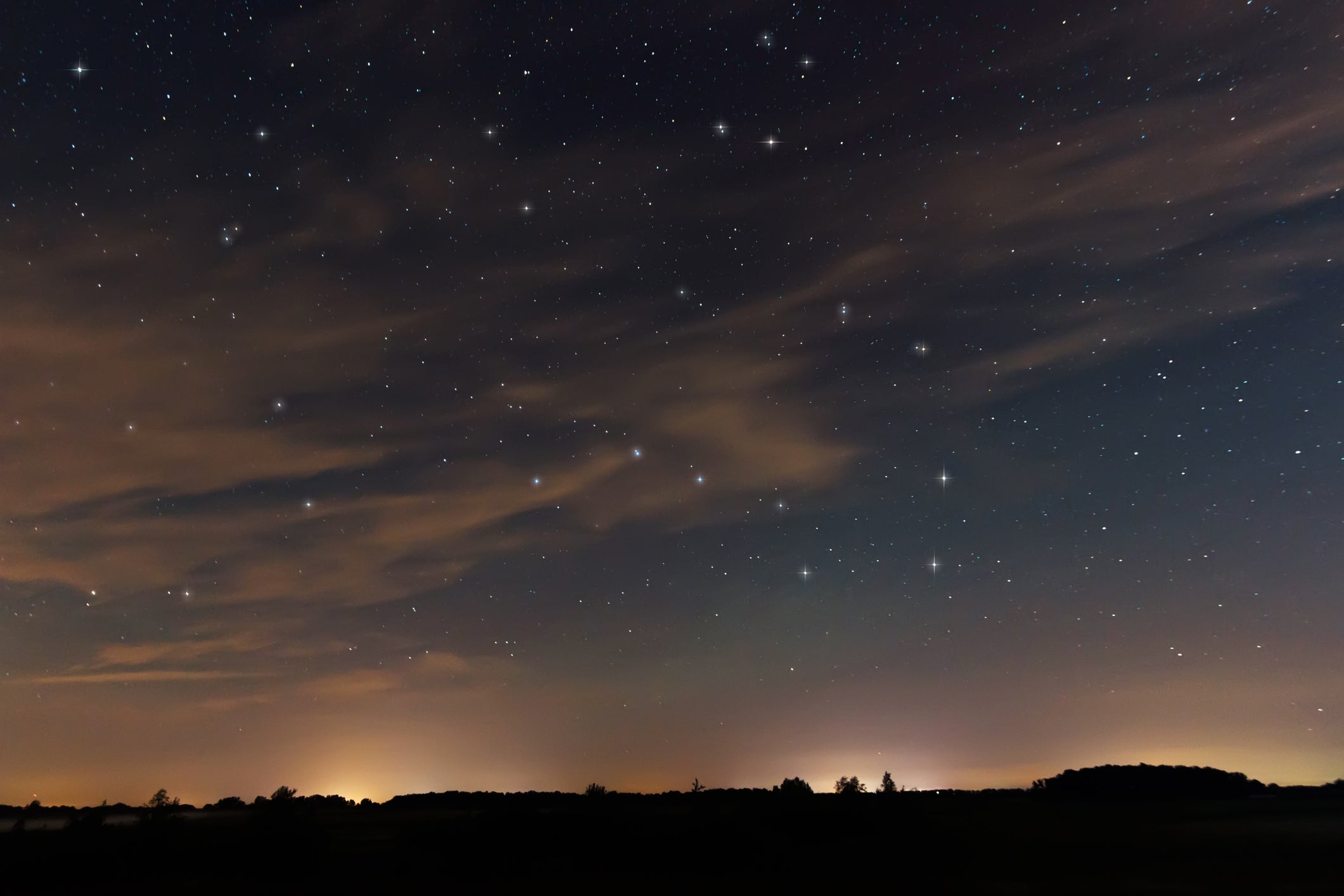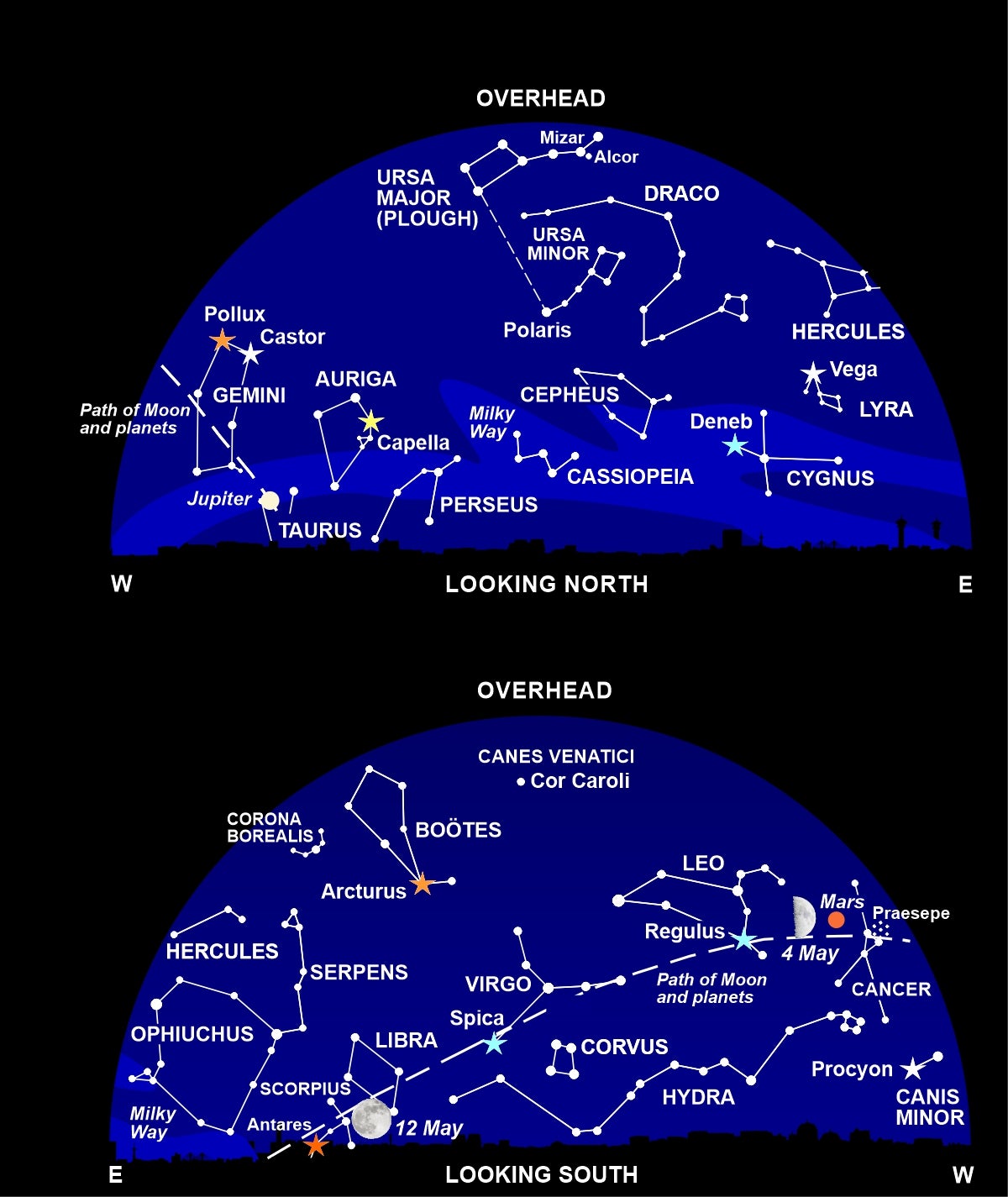Stargazing in May: A tale of two bears
The seven bright stars in Ursa Major are the most recognisable star pattern in the sky, Nigel Henbest writes

Once upon a time, back in the golden age of gods and humans, the great god Jupiter caught sight of a nymph named Callisto. Her name means "the most beautiful," and Jupiter was smitten. But Callisto was a follower of Diana, goddess of the hunt, and sworn to chastity. That didn’t deter Jupiter. He changed himself into the shape of Diana and lay down beside Callisto – who didn’t realise the deception.
When Callisto gave birth to a son, Arcas, she was expelled from Diana’s group. Worse still, Jupiter’s jealous wife Juno was on her trail. To protect Callisto, Jupiter turned her into a bear. Years passed, and Arcas – now a young man – stumbled across a bear while hunting in the woods. As he drew back his bow to bag this fine prize, Jupiter intervened to prevent the impending matricide: he turned Arcas into a bear, too, swung both ursines around by the stumpy tales and flung them into the sky, where they became the constellations we know to this day as the Great Bear (Ursa Major) and the Little Bear (Ursa Minor).
In each constellation, four stars mark the bear’s body, fainter stars (not shown on my star chart) depict their heads and legs, and a curve of three stars trace their long fluffy tails. And if you say – hey, bears don’t have long tails! – then consider that when you swing a heavy beast around by its stump of a tail, then something has got to give…
This account of the origin of the two celestial bears comes from the Roman poet Ovid, based on myths of the ancient Greeks. But the connection of Ursa Major with a bear goes back millennia earlier, to a bear-cult that was widespread across Siberia. Some astronomers think that Ursa Major is our oldest constellation, dating back 30,000 years to the time when humans crossed from Siberia into North America, because Native North American tribes also associate this star pattern with a bear. In their legends, the four stars in a rectangle depict the bear itself, while the three stars of the "tail" are a trio of hunters tracking it down.
The seven bright stars in Ursa Major are the most recognisable star pattern in the sky, along with Orion. In Britain, they traditionally form the Plough; though – with this agricultural implement now obsolete – many people call it the Saucepan. In contemporary North America it’s the Big Dipper, with its companion Ursa Minor denoted as the Little Dipper.
Look closely at the handle of the Saucepan (or Big Dipper) and you’ll see that the middle star – Mizar – has a fainter companion, called Alcor. It’s one of the few double stars that you can split with the naked eye. Mizar and Alcor are often called the Horse and Rider, though in the native American tradition where these stars are hunters, Alcor is the pot they are carrying to cook the bear after they’ve killed it.
The most famous star in the Little Bear is Polaris, otherwise known as the Pole Star or the North Star. As its name suggests, Polaris lies directly over the Earth’s North Pole, so it always lies to the north in the sky as our planet rotates under it. Locate the Pole Star by drawing a line from the two end stars of the Plough (see the star chart), and you know you facing due north.
As millennia pass, the Earth’s axis swings slowly around in space, so Polaris was not always the star above the spinning planet. When the Greek astronomer Ptolemy drew up the definitive list of constellations that we largely use today, around AD 150, the north pole of the sky lay about half-way along Ursa Minor. Instead of focusing on one star, Greek astronomers used the whole star-pattern to indicate north.
Greek navigators had an alternative name for the Little Bear – Kynosoura – which literally means "dog’s tail" and must derive from some other ancient constellation-makers now lost to history. Because Kynosoura was the focus for both astronomers and navigators, the word cynosure has passed down to us as something that’s the centre of attention, as in "the Mona Lisa is the cynosure of all eyes in the Louvre."
What’s Up
After blazing in our evening sky since last autumn, Jupiter is now on its way out. You can catch the giant planet low in the north-west after sunset, but it’s slipping down into the twilight glow. A narrow crescent Moon lies above Jupiter on 28 May.

Mars is gradually fading as the faster-moving Earth pull away from the Red Planet, and it’s now fainter than some of the stars in the evening sky. You’ll find Mars between Regulus, in Leo, and the twin stars Castor and Pollux in Gemini. The Moon is nearby on 3 May; and on the next evening Mars brushes across the top of the star cluster Praesepe (popularly known as the Beehive): a memorable sight in binoculars or a small telescope.
To the south, Leo’s leading light Regulus forms a large triangle with another bluish-white star – Spica, in Virgo – and orange Arcturus in Boötes. The dim sprawling constellations of Hercules and Ophiuchus are rising in the east.
There’s more action in the morning sky. First, if you’re up early on 6 May, watch out for particles from Halley’s Comet speeding across the heavens and burning up as shooting stars, in the Eta Aquarid meteor shower.
And Venus is putting on a brilliant show as the Morning Star, rising around 4am in the east. To its lower right – and 200 times fainter – you’ll find Saturn. On the mornings of 22, 23 and 24 May the crescent Moon moves past these two planets as it heads towards the month’s New Moon.
Diary
3 May: Moon near Mars
4 May, 2.52pm: First Quarter Moon; Mars very near Praesepe
5 May: Moon near Regulus
6 May, before dawn: Maximum of Eta Aquarid meteor shower
9 May: Moon near Spica
12 May, 5.56pm: Full Moon
21 May, 0.59am: Last Quarter Moon
22 May, before dawn: Moon near Saturn
23 May, before dawn: Moon between Venus and Saturn
24 May, before dawn: Moon near Venus
27 May, 4.02am: New Moon
28 May: Moon near Jupiter
30 May: Moon near Mars
Join our commenting forum
Join thought-provoking conversations, follow other Independent readers and see their replies
Comments